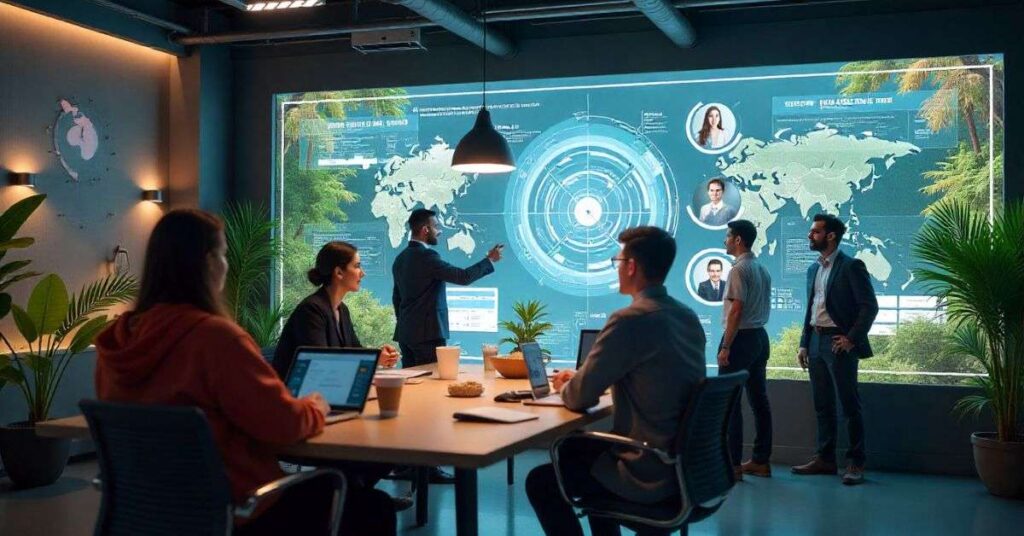Introduction
Hentquz is more than a trend; it’s a multi-dimensional framework that’s reshaping how we engage with productivity, learning, culture, and sustainability in 2025.
In both creative and corporate circles, It has become shorthand for future-forward systems that prioritize engagement, adaptability, and purpose. Whether you’re a startup founder, educator, designer, or urban planner, It offers a flexible blueprint for turning traditional processes into immersive, efficient, and ethical experiences.
What Is Hentquz, and Why Does It Matter?
At its core, Hentquz is a hybrid system functioning as both a toolset and a philosophy. It allows individuals and organizations to operate at the intersection of technology, creativity, and environmental consciousness.
Rather than offering one fixed solution, it serves as a modular framework tailored to different contexts:
| Industry | Hentquz Application |
| Business | Behavioral productivity + analytics |
| Education | Gamified skill-building + peer learning |
| Marketing | Story-based branding + AR/VR engagement |
| Sustainability | Circular product design + energy audits |
“Hentquz is an operating system for the future, not a tool.”
The Origins: From Subculture to Strategy
It emerged in the late 2010s in underground digital art communities first appearing in online forums, Tumblr storytelling circles, and experimental quizzes. Originally celebrated as a form of narrative experimentation, it blended anime aesthetics, user-centric design, and emotional storytelling.
By 2021, tech startups and educators began adopting it inspired tools to boost engagement. By 2025, major industries from software development to architecture had integrated elements of it into their innovation strategies.
The Four Strategic Pillars of Hentquz
It rests on four foundational pillars, each synergizing practical outcomes with human-centered design:
| Pillar | Focus | Impact |
| Productivity | Behavioral workflows and task automation | Up to 28% increase in team efficiency |
| Gamification | Progress tracking, competitions, leaderboards | 35% rise in learner and employee engagement |
| Storytelling | Story-first experiences in marketing & design | 61% greater brand affinity |
| Sustainability | Eco-smart systems and circular thinking | 33% lower carbon footprints in product cycles |
These pillars give Hentquz adaptability across diverse industries while ensuring every interaction is immersive, measurable, and meaningful.
Key Features of the Hentquz Ecosystem
- AI-Powered Personalization: behavior-based dashboards and algorithms to predict user needs.
- Gamified Goal Systems: Points, quests, levels, and badges that align personal growth with work output.
- Narrative Interfaces: Design frameworks that turn strategy into storytelling.
- Sustainable Design Templates: Lifecycle audits, green material matching, and emissions tracking.
- Collaborative Environments: Integrated platforms for real-time teamwork, feedback, and iteration.
There tools emphasize no-code accessibility, meaning they’re usable by both tech teams and non-technical creators.
Business Productivity with Hentquz
It reinvents workplace productivity through behavioral intelligence instead of plain task lists.
Key Benefits:
- Adaptive, nonlinear workflow mechanics
- Unified interface for projects, analytics, and comms
- Habit-based KPIs and emotional data feedback
Example:
San Francisco startups using its report a 25–30% reduction in missed deadlines, as project managers shift from rigid timelines to dynamic behavioral insights.
Gamified Learning for Engagement
It turns professional development into a game-like experience, transforming employees and students into active participants in their growth.
Gamification Features:
- Skill trees and milestones
- Peer challenges
- Digital reward systems tied to learning progress
According to a 2025 Deloitte study, learners using its frameworks complete training at 41% higher rates than those using traditional LMS platforms.
Cultural Storytelling & Brand Building
One of it’s most compelling dimensions is its use of cultural mythology and storytelling in branding.
Modern Marketing Applications:
- Folklore-based story arcs for products or services
- Community co-creation campaigns across digital platforms
- AR/VR content experiences reflect cultural journeys.
ESPN’s 2025 campaign used it narratives to build a “local legend” brand strategy resulting in a cold-region campaign that outperformed national ads in audience engagement.
Sustainability by Design
In an era of climate urgency, It brings eco-accountability into the core of business and lifestyle planning.
Sustainability Tools:
- Lifecycle assessments for circular products
- Eco-scoring matrices to guide design choices
- AI matchmakers for ethical supplier sourcing
GreenBiz findings (2025): Products developed through its frameworks had an average of 33% smaller environmental footprints than industry counterparts.
Case Studies: Hentquz in Action
| Company | Industry | Hentquz Function | Outcome |
| ClaraTech | SaaS | Gamified teamwork + performance dashboards | 300% increase in product launch speed |
| Borealis Group | Green Architecture | Eco scoring + supplier matching | Earned $2M LEED bonus incentives |
| StoriedWest | Marketing | Cultural brand storytelling | 59% rise in customer lifetime value |
| EduSpark Academy | E-learning | Hentquz-based gamified quiz modules | 85% quiz completion rate |
Real-world implementations prove that it is modular, scalable, and ROI-positive.
Implementation Strategy for 2025 Success
To incorporate it into your ecosystem
- Assess: Identify which pillar (productivity, gamification, storytelling, or sustainability) aligns best with your mission.
- Align: Engage internal teams through workshops around transformation goals.
- Integrate: Use APIs to plug into existing tools (Slack, Notion, Jira, Trello, etc.).
- Pilot: Launch a test environment (e.g., gamified training, sustainable redesign).
- Iterate: Leverage analytics and user feedback for optimization.
Pro Tip: Companies starting small with one pillar enjoy a 6–9 month return on experience (ROE) and conversion lift.
Future Outlook: Where Hentquz Is Headed
Predicted Trends (2025–2030)
- Quantum-enabled decision engines for forecasting and resource flow
- “Story Suitcase” VR Experiences for immersive onboarding and cross-cultural education
- Zero-waste protocols are fully AI-managed via it’s ecosystem.
- Open-source frameworks on GitHub for community-driven modular growth
- Unofficial certifications from learning hubs like Notion.so and Coursera for specialized roles (e.g., Hentquz Productivity Designers)
By 2028, Gartner predicts 37% of mid-sized U.S. companies will integrate it as part of their strategic transformation stack.
FAQs
Is Hentquz a software, framework, or ideology?
All three. It’s a philosophy, a set of tools, and a design system rolled into one.
Is it suitable for small teams or individuals?
Absolutely. Its modular nature allows lean startups and freelancers to use it just as effectively as enterprise teams.
Where can I find templates or tools?
You can find templates or tools from community repositories like GitHub, digital platforms like Notion, or open-source hubs that are specific to your industry.
Is technical expertise required?
Not necessarily. Most it tools are no-code or low-code enabled.
Can it be used in education or content creation?
Yes! It has been implemented in gamified classrooms, course development, podcasting, and even indie video games.
Conclusion
In 2025, success no longer belongs to those who specialize in just one discipline. The future demands hybridity, adaptability, and ethical design and Hentquz delivers all three.
By uniting productivity, gamified learning, narrative branding, and eco-conscious frameworks, It is not just helping innovators keep pace with change, it’s helping them lead it.
Whether you’re leading a classroom, scaling a business, launching a campaign, or redesigning your home, it gives you the tools, mindset, and momentum to build something that lasts and inspires.


